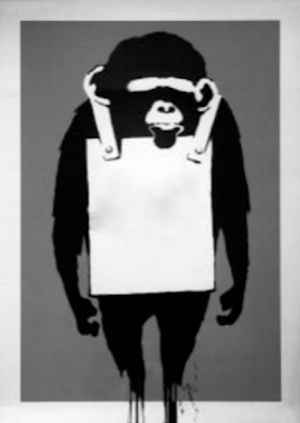R-1246/2021-5, Pest Control Office Ltd v Full Colour Black Ltd, EUIPO, 25th October 2022
COURT GETS
BEHIND BANKSY

Decision confirms the high bar for bad faith, writes Jason Aghatise
KEY POINTS
+
In an EU invalidity action based on bad faith the burden lies on the cancellation applicant to show that the trade mark proprietor acted in bad faith when it filed its registration
+
A trade mark proprietor is not obliged to know at the filing date when use of its trade mark will commence
+
In general, the filing of a trade mark consisting of a creation protected by copyright is neither automatically unlawful nor a circumvention of copyright law
MARK

Here, the EUIPO Fifth Board of Appeal (the BoA) overturned a decision to invalidate a trade mark registration of the well-known, yet anonymous, graffiti artist Banksy. The decision is the latest turn in the long-running dispute between Banksy’s authenticating body, Pest Control Office Ltd (the Proprietor), and the greeting card company Full Colour Black Ltd (the Applicant).
Background
In 2018, the Proprietor applied to register a figurative sign (the Sign) as an EU trade mark (EUTM) for a range of goods and services. The Sign represents part of Banksy’s iconic artistic works and was registered in June 2019 (the Registration). On 28th November 2019, the Applicant applied to invalidate the Registration on the grounds that it was filed in bad faith, and that the Sign was non-distinctive and descriptive.
In May 2021, the EUIPO’s Cancellation Division declared the Registration invalid. The key rationale for the decision was as follows:
a) Banksy chose to remain anonymous, and this choice hindered the ability to enforce copyrights. The Registration was filed in order for Banksy to obtain legal rights over the Sign, as the artist could not rely on copyright, but that is not a function of a trade mark.
b) At the time of filing, the Proprietor had never marketed or sold any goods (or rendered any services) under the Sign. The first sale occurred shortly before the filing of the invalidity application.
c) Evidence indicated Banksy had repeatedly invited others to copy, borrow, steal and amend their art for amusement, academic research or activism, with the exception of commercial use.
d) Banksy and their affiliates made public statements, including an admission that a pop-up shop was created to fulfil “trade mark categories under EU law” and Banksy’s infamous “copyright is for losers” comment.
The decision was appealed by the Proprietor.
Appeal decision
The Applicant argued the Sign lacked distinctive character because consumers would not perceive it as a badge of origin, but rather as purely artistic/decorative ornamentation. The Applicant provided several webpages demonstrating third parties selling goods (T-shirts, cushions, posters, etc) by reference to the Sign. However, the BoA noted that the Applicant failed to provide information on the number of visitors to those websites and evidence to establish the percentage of consumers that would see the Sign as decorative.
The BoA reaffirmed R 881/2014-5, DER KLEINE HEY in asserting that a creative work is eligible for trade mark protection, irrespective of whether that work has entered the public domain under copyright law.
"Public statements by Banksy and the artist’s affiliates were considered irrelevant"
The BoA concluded that the Sign did not allude to the goods and/or services protected by the Registration and consisted of an unusual combination of “quite striking” elements that would be kept in mind by consumers. The BoA was unconvinced by the arguments that the Sign was non-distinctive and descriptive, and these grounds were rejected.
Bad faith
In tackling the claim of bad faith, the BoA determined that while the Sign was widely available and Banksy authorised limited use to the public, these circumstances did not establish that the Proprietor never had an intention to use the Sign at filing of the Registration. In addition, the permission to use the Sign was expressly limited to non-commercial use. Although some evidence showed that third parties did commercially use the Sign, this did not establish implied permission from the Proprietor.
The claim that Banksy’s desire to maintain anonymity was the reason for filing the Registration was dismissed. The BoA highlighted the contradiction in Banksy “permitting” limited use of their copyright while declining to enforce their copyright for fear of losing their anonymity. Even if, as alleged, Banksy elected to protect the Sign via EUTM registration instead of copyright to remain anonymous, that position would not demonstrate an unwillingness to use the Sign when the Registration was filed.
The public statements by Banksy and the artist’s affiliates were considered irrelevant. The BoA cited freedom of expression pursuant to Article 19 ECHR. Moreover, it was not appropriate to extrapolate bad faith from such statements.
The BoA considered that the timing of the Proprietor’s use was not relevant as the Registration was not vulnerable to cancellation for non-use; proprietors have five years from the date of registration to use their trade marks and are not obliged to know at the filing date when they will start to use their trade marks. Further, given the same artwork can be protected by copyright and trade mark law, the filing of the Sign does not indicate bad faith to circumvent provisions of copyright law. It follows that there was no abuse of the trade mark system in the EU or abroad.
In conclusion, the BoA ruled that the Applicant had failed to establish the Registration was filed in bad faith.
Lessons to consider
This decision primarily reaffirms that in bad faith claims there is a presumption of good faith, as well as the high burden on a party bringing the claim. Second, the decision serves as a reminder that the five-year grace period provides proprietors of EUTMs time to prepare to use their marks, and so a bad faith claim requires more than non-use at the time of filing. Finally, copyrighted works can be registered as trade marks. However, if public use is permitted it is vital that such permission explicitly relates to non-commercial purposes only.
Note: It was not clear at the time of writing whether the decision will be appealed.

Jason Aghatise is a Chartered Trade Mark Attorney at Keltie
jason.aghatise@keltie.com
MORE STORIES


